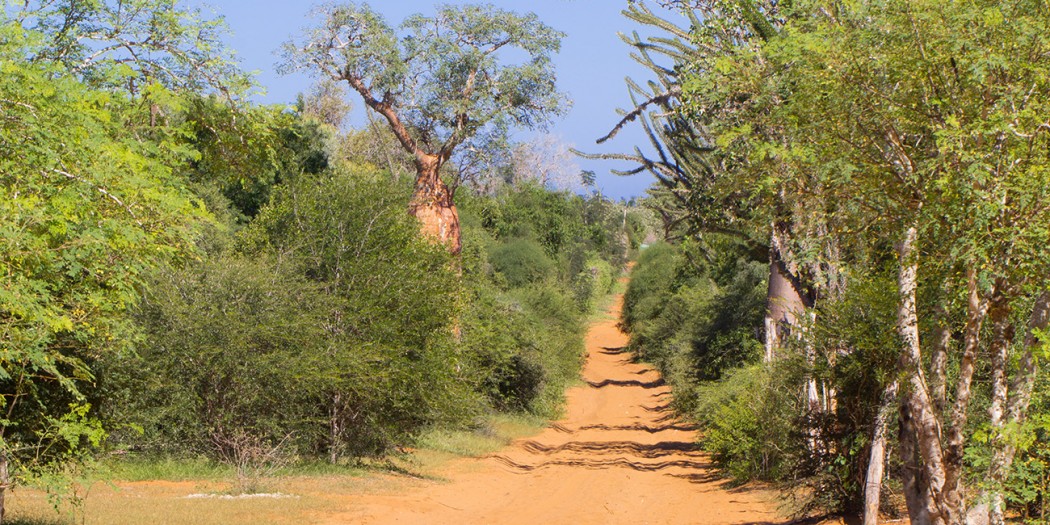Only few animals can survive in Madagascar’s dry, hot south for long. One of them is the Madagascar sand lizard (Chalarodon madagascariensis). Madagascar has no large iguanas like you probably know iguanas from America. Instead the local iguanas are rather small, agile and swift – they are so special, that they got their own family, which exists nowhere else on Earth: The Madagascan iguanas (Opluridae). The sand lizard is the smallest member of the family, it reaches only 20 centimetres in average – from the nose to the tip of the tail.

As you could expect from its name, it lives in South Madagascar in the very dry regions from the inland to the coast. The distribution area covers an area from Tsingy de Bemaraha and Zombitse to Toliara (Tuléar) at the southwest coast. In 2015, another sand lizard species was newly described, which populates southeastern Madagascar. The Madagascar sand lizard’s habitat consists of the edges of thorny forest, dry forests and hardly vegetated, sandy savannas. Here it is hot all the year round, and temperatures of 30°C and more are usual. Most years have only few days of rain. But the animals have adapted themselves perfectly to this conditions over centuries.
Madagascar sand lizards spend the night in dug subterranean caves. These cave systems protect them from predators and offer a comfortably coolth, which the animals appreciate in the noonday heat, too. Merely the common big-eyed snake, the fiercest opponent of the Madagascar sand leguans, chases the small reptiles down inside their holes.
By the way, this species was described in 1854 besides many other reptile species by German zoologist Wilhelm Peters after an expedition to the red island. He found the specimen in the bay of St. Augustin. This place is called Ianantsony today, is located near Toliara and still a good place to find sand lizards. The best time to do so is the rainy season, more exactly the months December to March. It’s mating time then, and the iguanas can be watched well. To court a female, the male iguanas show their brightest colours: The beige hues fade on the bacl into a bright yellow with bright spots, or yellow spots on more orange toned ground with brown stripes. The small dorsal ridge, which the females do not wear at all, brings off then, too.

Each male has its own territory of some meters in diameter now, which he vehemently defends against intruders. If another male sand lizard comes to close to the set borderline, the territory owner will begin to show threatening gestures. He whips his tail and bobs his head in direction of the contracant. An attack is only the last trial to chase the other iguana away. In most cases, the defeated lizard quickly runs away, bites and wounds are quite rare. In contrast, a female entering the territory is promptly courted. If the female is ready to mate, the male will bite into her neck immediately and keeps the bite for few seconds while fertilizing the female – that’s the whole mating process.
After two or three weeks, the female lays two small, white eggs in her underground cave system. It takes more than two months, before small Madagascar sand lizards hatch. They’re only two centimeters long, but can do everything like their parents: These reptiles are skilled hunters from the very first day of their life. The iguana’s daily diet mainly consists of insects, plants are only a small part of the diet from time to time. Due to their long hind legs, the long toes and the even long, stabilizing tail, Madagascar sand leguans can run over the hot sand lightning-quick without burning their feet.

Another characteristic, which is typical for iguanas, is the so called third eye. With this eye, Madagascar sand lizard cannot really see, but recognize contrasts and brightness. It is assumed that the parietal eye is part of the day-and-night-rhythm. Since Madagascar sand lizards occur in high numbers and exploit human settlements more and more as habitat, IUCN lists them as least concern. Thus they have no protection status, neither in Madagascar nor internationally. Whether this could become a problem in the future stays uncertain.
 MADAMAGAZINE Your Magazine about Madagascar
MADAMAGAZINE Your Magazine about Madagascar










